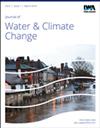Unraveling the dynamics of climate: empirical evidence from the Indian state of West Bengal
IF 3.1
4区 环境科学与生态学
Q2 WATER RESOURCES
引用次数: 0
Abstract
Abstract Understanding climate variability and trends is crucial for managing a host of sectors. Everything from water availability to agricultural productivity is affected by variability and trends in temperature, rainfall, evapotranspiration, and solar radiation. Nevertheless, their dynamics have seldom been explored together, especially in India. To address this gap, the present study investigates the variability, trend, and magnitude of those parameters individually and concurrently using fractal dimension and non-parametric statistics over the Indian state of West Bengal from 1951 to 2020. The results show a south–north gradient in overall climate variability. The Gangetic West Bengal (GWB) is experiencing higher variability, along with a rising minimum temperature (≥0.008 °C year−1) and declining rainfall (≥− 1 mm year−1). Though the Sub-Himalayan West Bengal as a whole shows less variability, its foothills reveal modest variation coupled with increasing maximum temperature (≥0.005 °C year−1), reference evapotranspiration (≥0.4 mm year−1), and decreasing rainfall in the post-monsoon and winter seasons. Based on the results, we identified the western GWB, the Sundarbans, and the sub-Himalayan foothills as the most vulnerable areas and recommended proactive crop and water management strategies. Finally, we underline the need to analyze climate dynamics holistically to manage climate-sensitive sectors efficiently and sustainably.解开气候动态:来自印度西孟加拉邦的经验证据
了解气候变率和趋势对于管理许多部门至关重要。从水资源供应到农业生产力,一切都受到温度、降雨、蒸发蒸腾和太阳辐射的变化和趋势的影响。然而,它们的动态很少被一起探讨,尤其是在印度。为了解决这一差距,本研究利用1951年至2020年印度西孟加拉邦的分形维数和非参数统计数据,分别和同时调查了这些参数的变异性、趋势和幅度。结果表明,总体气候变率呈南北梯度。恒河西孟加拉邦(GWB)正在经历更高的变异性,同时最低温度上升(≥0.008°C,年- 1)和降雨量下降(≥- 1毫米,年- 1)。尽管亚喜马拉雅西孟加拉邦整体表现出较小的变异性,但其山麓表现出适度的变化,伴随着最高温度(≥0.005°C - 1年)、参考蒸散量(≥0.4 mm - 1年)的增加,以及季风后和冬季降雨量的减少。根据研究结果,我们确定了西部GWB、孙德尔本斯和喜马拉雅山麓是最脆弱的地区,并建议了积极的作物和水资源管理策略。最后,我们强调需要全面分析气候动态,以有效和可持续地管理气候敏感部门。
本文章由计算机程序翻译,如有差异,请以英文原文为准。
求助全文
约1分钟内获得全文
求助全文
来源期刊

Journal of Water and Climate Change
WATER RESOURCES-
CiteScore
4.80
自引率
10.70%
发文量
168
审稿时长
>12 weeks
期刊介绍:
Journal of Water and Climate Change publishes refereed research and practitioner papers on all aspects of water science, technology, management and innovation in response to climate change, with emphasis on reduction of energy usage.
 求助内容:
求助内容: 应助结果提醒方式:
应助结果提醒方式:


